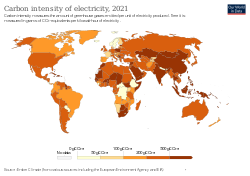Emission intensity

Emission intensity is a measure of how much pollution or harmful gases are produced per unit of activity or production. Think of it like baking cookies - the amount of flour, sugar, and butter you use is like the production activity, and the number of cookies you bake is like the emissions.
So, emission intensity measures how much pollution is emitted for every unit of production or activity, like how many cookies you bake for each cup of flour used. It helps to compare the amount of pollution produced between different activities or production processes.
For example, a factory that produces cars might emit more pollution than a factory that makes pencils, since making cars involves more energy and materials. But by measuring their emission intensity, we can see that the car factory might be more efficient in terms of emissions per car produced than the pencil factory is per pencil produced.
So, emission intensity is a tool we use to understand how much pollution is produced in relation to certain activities or production processes. It helps us make informed decisions about how to reduce pollution and make our activities more sustainable.
So, emission intensity measures how much pollution is emitted for every unit of production or activity, like how many cookies you bake for each cup of flour used. It helps to compare the amount of pollution produced between different activities or production processes.
For example, a factory that produces cars might emit more pollution than a factory that makes pencils, since making cars involves more energy and materials. But by measuring their emission intensity, we can see that the car factory might be more efficient in terms of emissions per car produced than the pencil factory is per pencil produced.
So, emission intensity is a tool we use to understand how much pollution is produced in relation to certain activities or production processes. It helps us make informed decisions about how to reduce pollution and make our activities more sustainable.
Related topics others have asked about:
